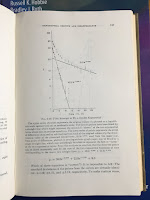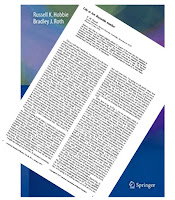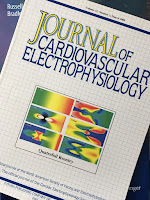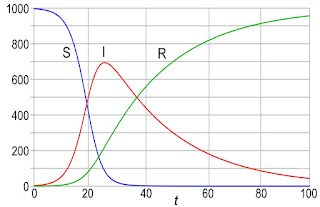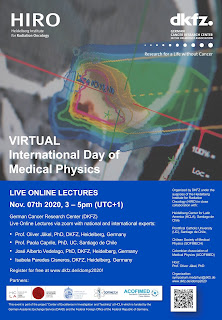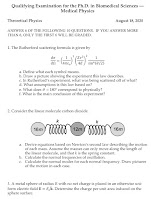Estimating the parameters [governing exponential decay] for the longest-lived term may be difficult because of the potentially large error bars associated with the data for small values of y. For a discussion of this problem, see Riggs (1970, pp. 146–163).
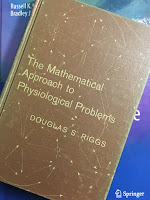 |
| The Mathematical Approach to Physiological Problems, by Douglas S. Riggs. |
It’s a gold mine. I particularly like the beginning of the preface. Riggs starts with what seems like an odd digression about hiking in the mountains, but then in the second paragraph he skillfully brings us back to math.
Before settling down in the village of Shepreth, in Cambridgeshire, England, to start working in earnest upon this book, I had the unusual pleasure of taking my family on a month-long youth hosteling trip through Northern England and the Scottish Highlands. For the most part, we bicycled, but occasionally we would make an excursion on foot up the steep hillsides and along the rocky ridges where no bicycle could go. We soon learned that the British discriminate carefully between “hill walking” and “mountain climbing.” To be a mountain climber, you must coil 100 feet of nylon rope around you slantwise from shoulder to waist, and have a few pitons dangling somewhere about. You are then entitled to adopt an ever-so-faintly condescending attitude toward any hill-walkers whom you may encounter along the trail, even if you meet them where the trail is practically level. Hill-walkers, on the other hand, remain hill-walkers even when the “walk” turns into a hands-and-knees job up a 40° slope of talus which is barely anchored to the mountain by a few wisps of grass and a clump or two of scraggly heather.One theme I stress in this blog is the value of simple models. Riggs agrees.
Mathematically speaking, this is a hill-walking book. It is necessarily so, since I myself have never learned the ropes of higher mathematics. But I do believe that the amount of wandering I have done on the lower slopes, the number of sorry hours I have spent lost in a mathematical fog, and the miles I have stumbled down false trails have made me a kind of backwoods expert on mathematical pitfalls, and have given me some practical knowledge of how to plan a safe mathematical ascent of the more accessible physiological hills.
Precisely because living systems are so very complex, one can never expect to achieve anything like a complete mathematical description of their behavior. Before the mathematical analysis itself is begun, it is therefore invariably necessary to reduce the complexity of the real system by making various simplifying assumptions about how it behaves. In effect, these assumptions allow us to replace the actual biological system by an imaginary model system which is simple enough to be described mathematically. The results of our mathematical analysis will then be rigorously applicable to the model. But they will be applicable to the original biological system only to the extent that our underlying assumptions are reasonable. Hence, the ultimate value of our mathematical labors will be determined in large part by our choice of simplifying assumptions.He then advocates for an approach that I call “think before you calculation.”
An investigator who publishes an erroneous equation has no place to hide! It is therefore prudent to check each calculation, each algebraic manipulation, and each transcription from a table of figures before going on to the next step. Above all, whenever you are engaged in mathematical work you should keep asking yourself over and over and over again, “Does this make sense?” and “Is this of the correct magnitude?”Riggs’s introduction ends with some wise advice.
All too frequently, students are willing to accept on faith whatever mathematical formulations they encounter in their reading. And why not? After all, mathematics is the exact science, and presumably an author would not express his theories or his conclusions mathematically without due regard for mathematical rigor and precision. It is only by bitter experience that we learn never to trust a published mathematical statement or equation, particularly in a biological publication, unless we ourselves have checked it to see whether or not it makes sense… Misprints are common. Copying errors are common. Blunders are common. Editors rarely have the time or training to check mathematical derivations. The author may be ignorant of mathematical laws, or he may use ambiguous notation. His basic premises may be fallacious even though he uses impressive mathematical expressions to formulate his conclusions… Caveat lector! Let the reader beware!What about the problem of fitting multiple exponentials to data, which is why Russ and I cite Riggs in the first place? After analyzing several specific examples, Riggs concludes
Riggs’s book examines many of the same topics that appear in the first half of IPMB, such as exponential growth, diffusion, and feedback. He has a wonderful chapter suggesting questions you should ask when checking the validity of an equation. Is it dimensionally correct? How does it behave when variables approach zero or infinity? Does it give reasonable answers after numerical substitution?These examples warn us not to take too seriously any particular set of coefficients and rate constants which we may get by plotting data on semi-logarithmic paper and ferreting out the exponential terms in the fashion described above. The need for such a warning is all too evident from the preposterously elaborate exponential equations which are sometimes published. The technique of “peeling off” successive terms is so deceptively easy! Fit a straight line, subtract, plot the differences, fit another straight line, subtract, plot the differences. How solid and impressive the resulting sum of exponentials looks! And how remarkably well the curve agrees with the observations. Surely the investigator can be pardoned a certain self-satisfaction for having so clearly identified the individual components which were contributing to the overall change. Yet, the examples discussed above show how groundless his satisfaction may be. It is undoubtedly true that the particular sum of exponentials which he happened to pick, plot, and publish fits the points with gratifying accuracy. But so also may other equations of the same general form but with quite different parameters. It is not great trick to have found one such equation. Even with a single exponential declining from a known value at time zero toward an unknown constant asymptote there are two parameters—the rate constant and the asymptote—to be fitted to the data. The effect of a considerable change in either may be largely offset by making a compensatory change in the other… Add a second exponential term with two more parameters to be estimated from the data, and the number and variety of “closely fitting” equations becomes truly bewildering. Worst of all, there are no simple statistical measures of the precision with which any of the parameters have been estimated. These considerations do not destroy the value of fitting an exponential equation to experimental data when it is suggested by some underlying theory or when it provides a convenient empirical way of summarizing a group of observations mathematically… But they make very clear the danger of using an empirical exponential equation to predict what may happen beyond the period actually covered by the observations. It is equally clear that we must be exceedingly skeptical when attempts are made to match the individual terms of an empirical exponential equation with supposedly corresponding processes or regions of the body.
Page 157 of The Mathematical
Approach to Physiological Problems,
showing a fit to a double exponential.
I’m impressed that Riggs, a professor and head of a Department of Pharmacology at SUNY Buffalo, could write so insightfully about mathematics. I give the book two thumbs up.
